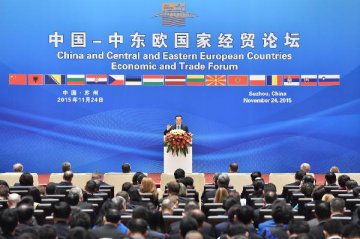
When accompanying leaders from 16 central and eastern European countries (CEE) to ride on China's most advanced bullet train on Wednesday, Chinese Premier Li Keqiang said "The trip mirrors China-CEE cooperation -- high speed, but comfortable and reassuring."
It is reasonable for Premier Li to draw such a metaphor as the just-concluded China-CEE summit has explored ways to boost all-round and sustainable cooperation between the two sides, which will also, in turn, facilitate cooperation between China and the whole Europe.
FRUITFUL, PRAGMATIC RESULTS
During the summit in Suzhou on Nov. 24-25, China and CEE countries identified priority sectors for cooperation from 2015 to 2020, ranging from infrastructure, finance, agriculture to people-to-people exchange, in a latest efforts to make their cooperation and coordination step into an all-round way.
With the accompany of Premier Li, leaders of CEE countries got to experience the "China speed" firsthand on Wednesday by boarding a China-made bullet train from Suzhou to Shanghai, which represents China's most cutting-edge high-speed rail technologies.
A day before that, China signed separate deals with Hungary and Serbia to construct and revamp a railway link between the two countries' capital cities, Budapest and Belgrade. Li pledged that construction of the railway would be underway by the end of the year and be finished within two years.
Upon its completion, the railway will help create a fast lane for trading between China and Europe. "The trip mirrors China-CEE cooperation -- high speed, but comfortable and reassuring," Li told the European leaders.
But for the summit, topics and achievements are far more than the high-speed railways. China has said it is willing to invest in port projects in CEE countries, citing its rich experience in port design and equipment manufacturing, as China started its reform and opening-up policy in coastal areas.
China will also work with parties involved to promote building of the China-Europe land-sea express passage, which will help strengthen connectivity and scale up trade between China and European countries, Li said.
Besides, as financing is the short plank of China-CEE cooperation, also known as "16+1" mechanism, China and CEE countries will explore opportunities to bring into full play the role of the 10 billion U.S. dollar special credit line, to create a 3 billion dollar investment fund and to establish a RMB fund in support of "16+1" cooperation.
Cooperation in currency swap, local currency settlement and financial regulation are encouraged. What is more, China and CEE nations will discuss the possibility of founding a multilateral financial firm. As Premier Li said, the summit would not only enhance mutual trust but boost practical cooperation, which will boost the all-round cooperation between China and Europe.
HUGE POTENTIAL FOR COOPERATION
Established as an annual event in Poland's capital of Warsaw in 2012, and subsequently staged in Romanian capital Bucharest and Belgrade, capital of Serbia, the new platform has greatly increased scope for cooperation.
"Faced with sluggish global trade and economy, China and CEE countries have maintained good momentum on practical cooperation, witnessing rapidly growing trade, investment and major cooperation projects underway," Premier Li voiced confidence in bilateral economic ties at an economic and trade forum of the summit.
According to the Ministry of Commerce of China, the total annual trade volume between China and CEE countries registered 43.9 billion dollars in 2010, and it increased to 60.2 billion dollars in 2014. "It's a large number, but it's just one-tenth of that between China and all the European countries," said Zhou Hong, a scholar with the Chinese Academy of Social Sciences.
"It means that there is great potential for it to grow more," he added. China plans to double its trade with the region by 2019, and, the market has been upbeat thanks to proactive efforts from both sides. Two-way investment is up: Chinese companies have invested more than 5 billion dollars in CEE countries and more than 1.2 billion dollars in investment has come flowing back, according to the commerce ministry.
"China and CEE countries complement each other in terms of their economic development, meaning they have strong desire to cooperate," Chinese Foreign Minister Wang Yi said during his visit to the Czech Republic, Poland and Bulgaria last month, adding that ties between China and CEE countries are playing a much more important role in China's relations with the whole Europe.
Wang Yiwei, professor at the Institute of International Affairs of Renmin University of China, noted that China is the largest developing country and the CEE region is home to many emerging economies.
Thus, the cooperation will be promising. "As CEE countries are going through profound economic restructuring under the changing economic climate of the world, it is imperative and of great vital for them to upgrade their infrastructures network, an area in which China has accumulated rich experience over the past several years," said Zhou Dongyao, a researcher from the Development and Research Center of the State Council of China.
Therefore, it provides a golden opportunity for China to further strengthen its ties with CEE countries, he noted. "China and CEE countries are rediscovering each other," said Cui Hongjian, a China-Europe relations specialist at the China Institute of International Studies.
BRIGHTER FUTURE OF DEVELOPMENT
Meanwhile, considering its geographic importance, central and eastern Europe marks an essential part in China's Silk and Road Initiative as a quarter of the countries along the routes are located in the region.
The initiative, proposed by Chinese President Xi Jinping in 2013 and comprising the Silk Road Economic Belt and the 21st Century Maritime Silk Road, is aimed at building a trade and infrastructure network connecting Asia with Europe and Africa along the ancient trade routes.
In June, China and Hungary inked a memorandum of understanding on promoting the initiative, the first such document China has signed with a European country. It is believed that the region would make full use of its geographic advantages as a linkage between Europe and Asia, Zhou Dongyao said.
"It's clear that the 16+1 mechanism will give new impetus to building direct links and expanding cooperation and coordination between China and Europe, he said. Take the rail link as an example. A well-established railway system between China and CEE countries will greatly reduce the time and labor costs, facilitate cooperation with partners and strengthen trade relations between China and CEE countries as well as the whole Europe. Hungarian Minister of Foreign Affairs and Trade Peter Szijjarto hailed the far-reaching effect of the Silk and Road Initiative on the inter-connectivity of the whole continent of Eurasia.
"Hungary has attached great importance to our partnership with China," Szijjarto said, expressed hopes for the seamless docking between the Belt and Road Initiative and Hungary's foreign policy of "Opening-up to the East." As China is a long-term partner for Europe, its cooperation with CEE countries is win-win cooperation, said Kong Tianping, a researcher with Chinese Academy of Social Sciences.
"China's cooperation with CEE countries has gradually gained recognition from the European countries, because it has promoted the balanced development and the integration of Europe," he added.
















Latest comments